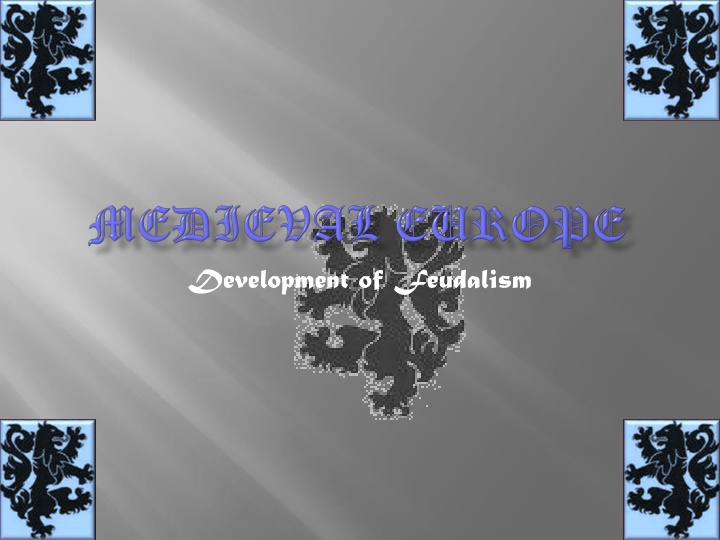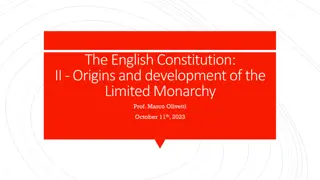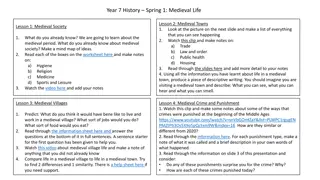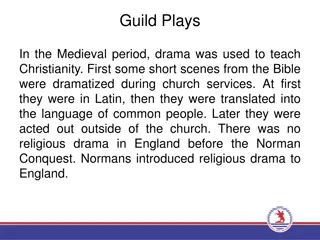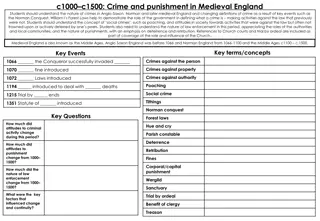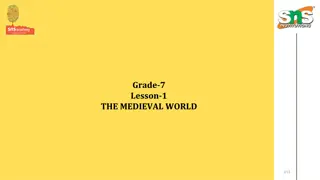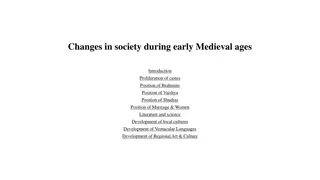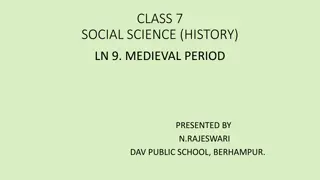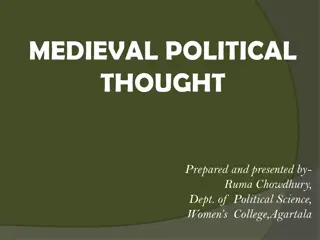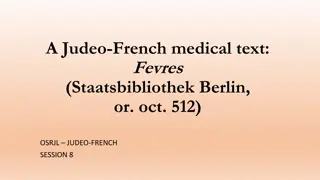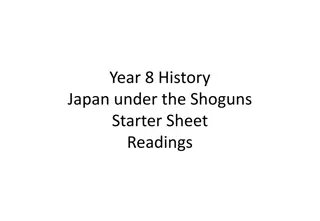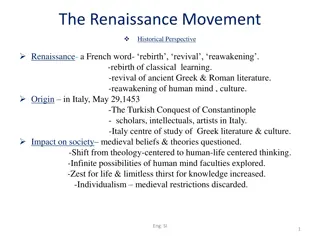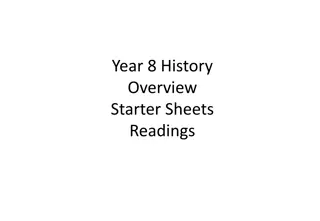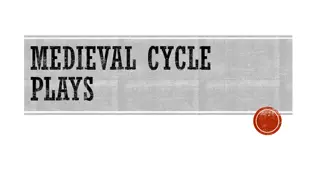Development of Feudalism in Medieval Europe
Feudalism in Europe began with the fall of Rome, leading to a system where monarchs, lords, knights, and peasants played key roles. The Franks emerged as a powerful group with a new warfare system, and Charlemagne unified European lands into an empire. However, the empire faced challenges after his reign, as weak rulers struggled to defend it against invasions, following the practice of rewarding knights for service. This era saw significant social and political shifts, with the feudal system shaping society and governance.
Download Presentation

Please find below an Image/Link to download the presentation.
The content on the website is provided AS IS for your information and personal use only. It may not be sold, licensed, or shared on other websites without obtaining consent from the author.If you encounter any issues during the download, it is possible that the publisher has removed the file from their server.
You are allowed to download the files provided on this website for personal or commercial use, subject to the condition that they are used lawfully. All files are the property of their respective owners.
The content on the website is provided AS IS for your information and personal use only. It may not be sold, licensed, or shared on other websites without obtaining consent from the author.
E N D
Presentation Transcript
Early Middle Ages: 476 to 1000 CE The High Middle Ages: 1000 to 1300 The Late Middle Ages: 1300 to 1450
Began with the fall of Rome Life was dangerous and difficult People needed protection from invading barbarians and kingdoms People worked hard just to survive and have enough food
The economic and political system during the Early Middle Ages
Monarch Lords Knights Peasants
Franks: a powerful group because they developed a new system of warfare Depended on troops of heavily armed warriors who fought on horseback Ruler needed the service and loyalty of many knights Knights were rewarded with land and privileges
Married a Christian woman, Clotilda Eventually baptized into the Roman Catholic Church, a Christian church headed by the pope in Rome His followers became Christians Led the Franks in wars that widened the boundaries of the Frankish kingdom
Most important leader of the Franks Ruled for over 40 years, from 768-814 Unified nearly all the Christian lands of Europe into a single empire With the help of Pope Leo III, he built his empire Leo, in turn, got support from someone who had an army Pope Leo crowned Charlemagne Holy Roman emperor in 800 CE
Charlemagnes empire quickly fell after his death in 184 Weak rulers who followed him could not defend the empire against new waves of invasions These kings followed Charlemagne s example of rewarding knights with land and privileges in return for military service
The Muslims came from the Near East and northern Africa into what is now Spain The Magyars, a central Asian people, came from the east The Vikings came down from present-day Norway and Denmark Western Europeans developed a system we call feudalism to defend and protect themselves
a stable social order People were bound to one another by promises of loyalty All land in the kingdom belonged to the monarch Great deal of land belong to the church
Gave fiefs, or grants of land, to his most important lords who became vassals Each lord promised to supply the king with knights in times of war King Enlisted lesser lords and knights as his vassals Lord Rented land from the lords Some were called serfs and were tied to the land they worked Farmed the land in return for a small plot of land of their own Peasants
Large estates held by a lord Most lords and wealthier knights lived on manors Included a castle or manor house, one or more villages, and the surrounding farmland Located in the country far from towns, so peasants had to produce everything the people on the manor needed
Were feudal lords Expected to keep order and to provide protection for their vassals Believed in the divine right of kings The idea that God had given them the right to rule Power of the monarchs varied Relied on their vassals, especially nobles, to provide enough knights and soldiers Some lords grew very powerful and governed their fiefs as independent states
Came to power in England after: the king died without an heir William believed he had the right to the English throne Harold, his cousin, was crowned William and his army invaded England Defeated Harold at the Battle of Hastings Nickname William the Conqueror Brought feudal instittutions from Europe with him. Brought order to England By the High Middle Ages, around 1000 C.E., much of Europe was stable because of feudalism
Highest-ranking class in medieval society Most lived on manors Some had several manors which the lords stayed at for a few months at a time with their families
Many of the people on a manor lived with the lord s family in the main house (manor house) Built of wood or stone Surrounded by gardens and outbuildings (such as stables) Protected by high walls and sometimes a moat Center of the community Villagers entered its walls for protection if there was trouble
Kings and queens, high-ranking nobles, and wealthy lords lived in castles Main function was to serve as a home Also one of the most important forms of military technology Had moats, strong walls, and gates to protect those who live inside Its large size and central locations were strong visual reminders of the hierarchy within the kingdom and the strict barriers between classes
Responsible for managing and defending his land and the people who worked it Appointed officials to make sure villagers carried out their duties Acted as judges in manor courts Had the power to fine and punish those who broke the law Some held posts in the king s government During war, lords fought for their own higher-ranking lords, or supplied them with a well-trained fight force
Responsible for raising and training their children and sometimes the children of other noble families Oversaw their household or households Entertainment provided by musicians and jesters ( fools who performed amusing jokes and stunts)
Hunting and hawking (hunting with birds) Feasting and dancing Board games such as chess Reading Ladies did fine embroidery, or decorative sewing
Lit by candles only Warmed by open fires Could be gloomy and cold Little or no privacy Fleas and lice infected all medieval buildings People bathed only once a week Clothes not washed daily Diseases affected everyone War was a constant danger
Mounted soldiers Had to have some wealth because a full suit of armor and a horse cost a small fortune Usually vassals of more powerful lords
Start as a page, or servant After 7 years, became a squire Became a knight in his early 20s if he was deserving
It was a way of life Lived by a strong code of behavior called chivalry (included bravery, loyalty, and respect for women) Expected to be loyal to their church and their lord Expected to be just and fair Expected to protect the helpless Performed acts of gallantry (respect to women)
Participated in jousts and tournaments Fought wearing heavy suits of armor 11th century: armor was made of metal ring linked together 14thcentury: plate armor was more common and offered better protection
Supported the entire feudal structure by working the land Their labor allowed lords and knights to spend their time preparing for war or fighting Legally classified as free or unfree Free peasants: rented land to farm and owed only their rent money to the lord Unfree peasants (serfs): farmed the lord s fields and could not leave; they received a small plot of land of their own to farm
Revolved around work Raised crops Tended livestock (animals) Every manor had carpenters, shoemakers, smiths (metalworkers), and other skilled workers Women worked the fields when needed Women also cared for their children and homes
Serfs owed the lord numerous taxes Head money : paid a fix amount per person every year Tallage: lord could demand this tax whenever he needed money Merchet: this fee was paid by a woman, her father, or her husband when she married
Required to grind their grain at the lord s mill (which was the only mill in the village) The miller kept portions of the grain for himself and the lord who could keep any amount he wanted Serfs hated this practice and some hid small hand mills in their houses
Small houses of 1 or 2 rooms Made of woven strips of wood covered with straw or mud Had little furniture or possessions Hearth fire in the middle of the main room, but usually no chimney so it was dark and smoky inside An entire family might eat and sleep in one room that sometimes also housed their farm animals
Vegetables, meat such as pork, and dark, coarse bread made of wheat mixed with rye or oatmeal In the winter, they ate meat and fish that had been preserved in salt Herbs were used for flavor and to lessen the taste of the salt or to disguise the taste of meat that was no longer fresh
